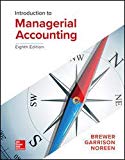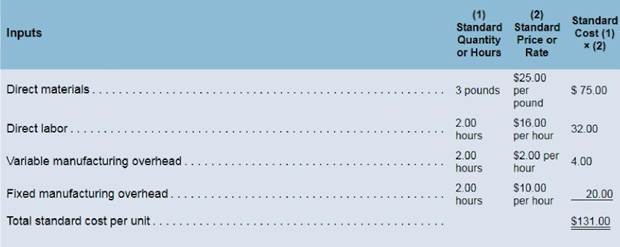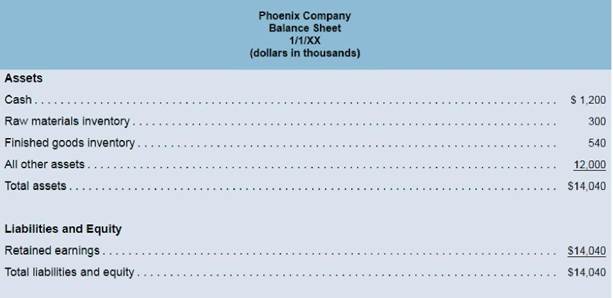
Concept explainers
Transaction Analysis; Income Statement Preparation
The company's

Phoenix Company manufactures only one product and uses a standard cost system. The company uses a plantwide predetermined

During the year Phoenix completed the following transactions:
a. Purchased (with cash) 460.000 pounds of raw material at a price of $26.50 per pound.
b. Added 430.000 pounds of raw material to work in process to produce 125.000 units.
c. Assigned direct labor costs to work in process. The direct laborers (who were paid in cash) worked 265.000
hours at an average cost of $1 5.00 per hour to manufacture 125.000 units.
d. e portion of the
predetermined overhead rate multiplied by the number of direct labor-hours allowed to manufacture 125.000
units. Actual variable
e. Applied fixed manufacturing overhead to work in process inventory using the fixed portion of the predetermined
overhead rate multiplied by the number of direct labor-hours allowed to manufacture 125,000 units. Actual fixed
manufacturing overhead costs for the year were $2,450,000. Of this total, $1,300,000 related to items such as
insurance, utilities, and salaried indirect laborers that were all paid in cash and $1, 150,000 related to
of equipment.
f Transferred 125.000 units from work in process to finished goods.
g. Sold (for cash) 123,000 units to customers at a price of $1 75 per unit.
h. Transferred the standard cost associated with the 123.000 units sold from finished goods to cost of goods sold.
i. Paid $3,300,000 of selling and administrative expenses.
j. Closed all standard cost variances to cost of goods sold.
Required:
- Compute all direct materials, direct labor, variable overhead, and fixed overhead variances for the year.
Want to see the full answer?
Check out a sample textbook solution
Chapter 9 Solutions
GEN COMBO LOOSELEAF INTRODUCTION TO MANAGERIAL ACCOUNTING; CONNECT AC
- Classify the following account: Prepaid Insurance – Asset, Liability, Equity, Revenue, or Expense? Need helparrow_forwardClassify the following account: Prepaid Insurance – Asset, Liability, Equity, Revenue, or Expense?arrow_forwardJournalize the following transaction: Purchased equipment worth $10,000, paying $4,000 in cash and the balance on credit.arrow_forward
 Cornerstones of Cost Management (Cornerstones Ser...AccountingISBN:9781305970663Author:Don R. Hansen, Maryanne M. MowenPublisher:Cengage Learning
Cornerstones of Cost Management (Cornerstones Ser...AccountingISBN:9781305970663Author:Don R. Hansen, Maryanne M. MowenPublisher:Cengage Learning Managerial AccountingAccountingISBN:9781337912020Author:Carl Warren, Ph.d. Cma William B. TaylerPublisher:South-Western College PubPrinciples of Accounting Volume 2AccountingISBN:9781947172609Author:OpenStaxPublisher:OpenStax College
Managerial AccountingAccountingISBN:9781337912020Author:Carl Warren, Ph.d. Cma William B. TaylerPublisher:South-Western College PubPrinciples of Accounting Volume 2AccountingISBN:9781947172609Author:OpenStaxPublisher:OpenStax College Principles of Cost AccountingAccountingISBN:9781305087408Author:Edward J. Vanderbeck, Maria R. MitchellPublisher:Cengage Learning
Principles of Cost AccountingAccountingISBN:9781305087408Author:Edward J. Vanderbeck, Maria R. MitchellPublisher:Cengage Learning Managerial Accounting: The Cornerstone of Busines...AccountingISBN:9781337115773Author:Maryanne M. Mowen, Don R. Hansen, Dan L. HeitgerPublisher:Cengage Learning
Managerial Accounting: The Cornerstone of Busines...AccountingISBN:9781337115773Author:Maryanne M. Mowen, Don R. Hansen, Dan L. HeitgerPublisher:Cengage Learning College Accounting, Chapters 1-27AccountingISBN:9781337794756Author:HEINTZ, James A.Publisher:Cengage Learning,
College Accounting, Chapters 1-27AccountingISBN:9781337794756Author:HEINTZ, James A.Publisher:Cengage Learning,





